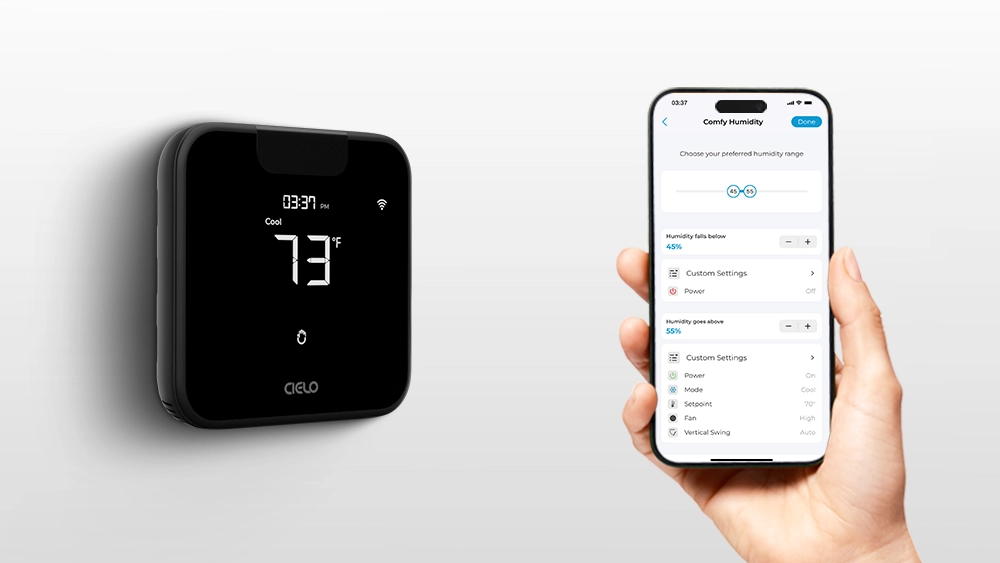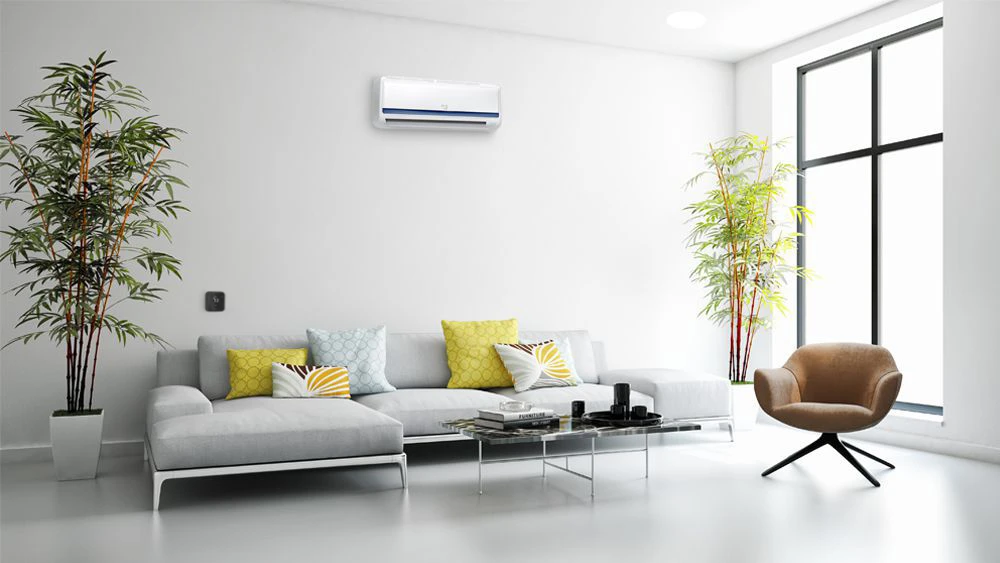
Key Takeaways
- Air conditioners not only cool indoor spaces but also dehumidify them.
- If your home is humid with the AC on, it indicates your AC is oversized or not well-maintained.
- Dirty coils, leaky ducts, and wrong thermostat settings can also impact your HVAC humidity control.
Your air conditioning unit might have been your best buddy to regulate your home temperature. But are you aware of HVAC humidity control?
Humidity plays a significant role in maintaining a perfect home climate, especially during summers. The optimal humidity levels for summer should be around 40%-50%. Additionally, high moisture levels can become a source for viruses, bacteria, and mold to thrive. This can greatly impact your indoor air quality.
Fortunately, you can manage temperature as well as humidity with your air conditioning system!
Does HVAC Remove Humidity?
Yes! Generally, it is believed that an HVAC unit can only cool or heat a room. Even though the primary function of an air conditioner is to introduce cool air, it also removes moisture as a byproduct.
You don’t have to change any setting for it to remove humidity. The cooling process involves removing moisture from indoors. This is referred to as condensation. It happens through the evaporator coils and is a part of how an air conditioner works.
How Is Humidity Controlled With an AC System?
Do you know how water vapor appears on the outside of a glass containing a cold beverage? Your air conditioning system has evaporator coils that condense moisture from indoor air in a similar way.
The hot and moist air inside your room is taken to the cold evaporator coils. This air is condensed, and the liquid is taken out of it through condensation. The moisture is collected in the drain pan and is sent outside your house through a drain pipe. This process results in the dehumidification of your room.
Your best choice to make any mini-split, window,
or portable AC smart. Enhance your comfort and savings.

Reasons Why Your HVAC Humidity Control Isn’t Working for You
While an air conditioner can bring down humidity to a significantly low level, sometimes you may struggle with it. You may notice that even though your AC is running but the moisture count is still high. You may wonder why is my home humid with the AC on? This can be due to plenty of reasons:
1. Limited Speed Controls
Like an oversized unit, an air conditioner that only offers one speed or just an on/off function disturbs HVAC humidity control. With no speed options, your unit turns on and runs at full blast to achieve your desired temperature. And as soon as it is achieved, your unit turns off, and the cycle repeats.
During this process, your HVAC system doesn’t get enough time for proper dehumidification. This becomes a cause of concern, especially if you live in a high humid area.
A modulating AC, on the other hand, offers multiple speed controls. Therefore, it is best to go for a modulating system when thinking of an upgrade. Since it offers multiple speed controls, you’ll also notice a difference in your air conditioning costs.
Related: HVAC Controls: All You Need to Know
2. Oversized HVAC Unit
If you’re a homeowner, then a big or oversized HVAC unit might entice you. You may think the bigger it is, the better results you’ll get. However, that is not the case.
If you have a large air conditioning system, you’ll struggle to regulate temperature as well as HVAC humidity control.
Remember, when talking about the size of an air conditioner, you don’t only need to consider its size but also its cooling capacity.
An oversized HVAC system will have a powerful compressor. It will turn on and off frequently. Hence, your air conditioner won’t run long enough to dehumidify your room.
Here is our guide for air conditioner sizing.
3. Negative Air Pressure
An improper ventilation system of your home may lead to building up negative pressure indoor. The negative air pressure is created when there is too much venting from any space.
You must’ve noticed how air rushes inside when someone opens the main door or a window. This is because too much negative pressure forces the air to keep a balance by drawing in more air from the outside. And when the humidity levels go to an extreme level, the muggy air enters your home compromising your HVAC humidity control.
Read our guide and improve your home ventilation.
4. Wrong Thermostat Setting
While setting up your thermostat, you may only think about what temperature would be the best. However, it is equally important to keep humidity in mind as well.
For instance, you’re running your air conditioner in fan mode. It’ll benefit to increase the airflow inside your room without introducing the cooled air. But this can also result in an increased moisture level. The water vapor inside your unit that hasn’t yet moved outside may travel back to your room.
It is best to first check the humidity levels inside your home and then choose the right thermostat setting.
5. Dirty Evaporator Coils
Evaporator coils are the main component inside your air conditioner that is primarily responsible for dehumidification. They can get dirty with time impeding their functionality.
The dirt particles will act as an insulator preventing the removal of water vapor from the air. This not only decreases your air conditioner’s cooling capacity but also impacts the dehumidification process.
If you’re feeling a change in your aircon’s working, check if evaporator coils need cleaning.
Here is a DIY guide to AC coil cleaning.
6. Leaky Ductwork
Any source of moist air infiltrating your home would be a cause behind increased humidity levels. If your ductwork has leakage, especially on the return side, it’ll end up sucking the hot, humid air from around the ducts. The air conditioner would not be able to remove an extremely high amount of moisture in this case.
It is best to inspect your ducts if you’re having issues with HVAC humidity control and fix the leaks as soon as possible.
7. Outdated HVAC Unit
As your HVAC unit ages, you may notice gradual changes in its working capacity. It might not cool the way it used to, may not be as energy-efficient, may have increased maintenance costs. In addition to that, you may also see that your HVAC humidity control isn’t working sufficiently to maintain the ideal levels.
The reason is that over time, your unit’s capacity to cool and dehumidify decreases. This may mean that you need to replace your unit. The average life of an air conditioner is around 10-15 years. So, if it has crossed that mark or is near the line, it’s time to start thinking about your choices.
Why Is My Home so Humid With the AC On?
In addition to your air conditioning unit, several other factors also contribute to HVAC humidity control. The design, construction material, geographical location, how air-tight your house is; all these things play their role in managing humidity.
For example, if you live in a scorching climate, your AC would be running most of the time. It’ll have enough time to dehumidify the indoor air. On the other hand, if you need to run your AC for a limited time or only when the sun is harsh, then it may not bring down moisture count to a significantly low level.
Humidifiers vs. Dehumidifiers vs. Air Conditioners
While air conditioners dehumidify the air, it should be kept in mind that their primary function is to introduce cool air. Therefore, the humidification is more of an effect of the cooling process happening inside the unit.
So, if you’re struggling with HVAC humidity control, it is best to consider other options to manage the moisture level inside your home.
Humidifiers and dehumidifiers are the two devices that help combat humidity problems. If your home is always humid, then you’d need a dehumidifier. On the contrary, if the air around your home is dry and humidity levels always remain low, then you’d need a humidifier.
Read this article to learn if you need a dehumidifier or your AC would do the job!
Can You Add Humidity Control to HVAC?
Humidifiers and dehumidifiers are separate devices. While your AC can dehumidify the air, its capacity to remove moisture won’t be equal to that of a humidifier.
If you have a central air conditioner, you can add any of these devices depending upon your needs. These can be installed as part of your system to enhance HVAC humidity control.
Smart HVAC Humidity Control

You can opt for a smart solution for HVAC humidity control. Pair your central ACs with a smart thermostat and mini-splits, window, and portable ACs with smart AC controllers. These smart home climate control devices will take your temperature and humidity control in the air conditioning system to the next level.
You’ll be able to manage home humidity using your smartphone from anywhere, anytime! Using Comfy Mode, you can set a humidity range, and your air conditioner will run to maintain it.
Isn’t it cool that you won’t need to buy another device to measure your home humidity? You can always check it on your phone.
Now, set intelligent triggers, sit back, and automate your HVAC humidity control for a perfect home environment!









2 Comments. Leave new
Hi
I want to offer to my customers a solution which makes possible to set temperature and humidity control. Let say I want to use a split Ac system and to achieve a temperature of 24C and 45%RH. How can I control humidity with your device? The thermostat will stop the AC when the set temperature is achieved. How your device know how much the humidity is? What happens if the thermostat stops the AC unit but the humidity drops to 30%RH? Can you explain me in more details? What about when using a furnace heating in winter and set the temperature to 21C and 50%RH and I need a humidifier.
Awaiting your kind reply
Pohl Zoltan
Thank you for your comment. Our customer support team can best help in detail with this. You can reach out to them at support@cielowigle.com or call (+1) 425 529 5775. They are available 09:00 AM – 09:00 PM ET, Mon-Fri. There will be no long queues, and we answer 98% of the calls in less than 2-3 minutes. You will be talking to a human – and that’s true!